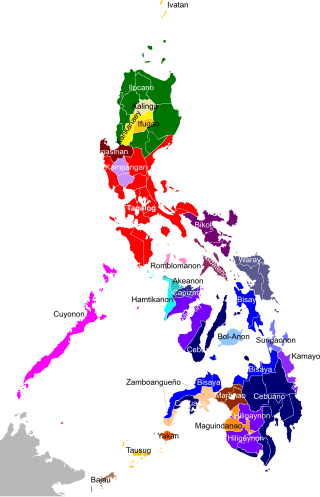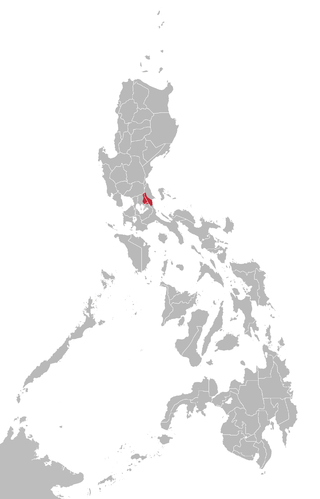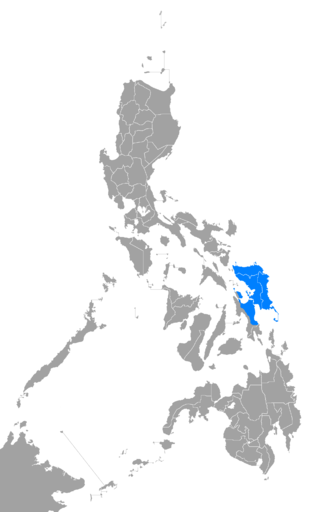Related Research Articles

The Bisayan languages or Visayan languages are a subgroup of the Austronesian languages spoken in the Philippines. They are most closely related to Tagalog and the Bikol languages, all of which are part of the Central Philippine languages. Most Bisayan languages are spoken in the whole Visayas section of the country, but they are also spoken in the southern part of the Bicol Region, islands south of Luzon, such as those that make up Romblon, most of the areas of Mindanao and the province of Sulu located southwest of Mindanao. Some residents of Metro Manila also speak one of the Bisayan languages.

Maranao is an Austronesian language spoken by the Maranao people in the provinces of Lanao del Sur and Lanao del Norte and the cities of Marawi and Iligan City in the Philippines, as well as in Sabah, Malaysia. It is a subgroup of the Danao languages of the Moros in the Bangsamoro Autonomous Region in Muslim Mindanao.
The Central Philippine languages are the most geographically widespread demonstrated group of languages in the Philippines, being spoken in southern Luzon, Visayas, Mindanao, and Sulu. They are also the most populous, including Tagalog, Bikol, and the major Visayan languages Cebuano, Hiligaynon, Waray, Kinaray-a, and Tausug, with some forty languages all together.

Surigaonon is an Austronesian language spoken by Surigaonon people. As a regional Philippine language, it is spoken in the province of Surigao del Norte, Dinagat Islands, Surigao del Sur, and some portions of Agusan del Norte, especially the towns near Lake Mainit, Agusan del Sur and Davao Oriental.

The Philippine languages or Philippinic are a proposed group by R. David Paul Zorc (1986) and Robert Blust that include all the languages of the Philippines and northern Sulawesi, Indonesia—except Sama–Bajaw and the Molbog language—and form a subfamily of Austronesian languages. Although the Philippines is near the center of Austronesian expansion from Taiwan, there is relatively little linguistic diversity among the approximately 150 Philippine languages, suggesting that earlier diversity has been erased by the spread of the ancestor of the modern Philippine languages.

The Philippines is inhabited by more than 182 ethnolinguistic groups, many of which are classified as "Indigenous Peoples" under the country's Indigenous Peoples' Rights Act of 1997. Traditionally-Muslim peoples from the southernmost island group of Mindanao are usually categorized together as Moro peoples, whether they are classified as Indigenous peoples or not. About 142 are classified as non-Muslim Indigenous people groups, and about 19 ethnolinguistic groups are classified as neither Indigenous nor Moro. Various migrant groups have also had a significant presence throughout the country's history.

The Batanic languages are a dialect cluster of the Austronesian language family. They are spoken on Babuyan Island, just north of Luzon; three of the Batanes Islands, between the Philippines and Taiwan; and on Orchid Island of southern Taiwan.
The Subanen languages are a group of closely related Austronesian languages belonging to the Greater Central Philippine subgroup. Subanen languages are spoken in various areas of Zamboanga Peninsula, namely the provinces of Zamboanga Sibugay, Zamboanga del Norte and Zamboanga del Sur, and in Misamis Occidental of Northern Mindanao. There is also a sizeable Subanen community in Misamis Oriental. Most speakers of Subanen languages go by the name of Subanen, Subanon or Subanun, while those who adhere to Islam refer to themselves as Kolibugan, "Kalibugan", "Tewlet" or "Telet".

The Sama–Bajaw languages are a well-established group of languages spoken by the Sama-Bajau peoples of the Philippines, Indonesia, and Malaysia.

Remontado, also known in literature as Sinauna, Kabalat, Remontado Dumagat, and more commonly by the autonym Hatang-Kayi, is a Malayo-Polynesian language spoken in Tanay, Rizal, General Nakar, Quezon, Rodriguez, Rizal and Antipolo, in the Philippines. It is one of the Philippine Negrito languages. It is a moribund language.
Arta is a highly endangered Negrito language of the northern Philippines.
Manide is a Philippine language spoken throughout the province of Camarines Norte in Bicol region and near the eastern edge of Quezon in Southern Tagalog of southern Luzon in the Philippines. Manide is spoken by nearly 4,000 Negrito people, most of whom reside in the towns of Labo, Jose Panganiban, and Paracale.
The Negrito peoples of the Philippines speak various Philippine languages. They have more in common with neighboring languages than with each other, and are listed here merely as an aid to identification.
Inagta Rinconada is a Bikol language spoken by a semi-nomadic hunter-gatherer Agta (Negrito) people of the Philippines. It is spoken to the east of Iriga City up to the shores of Lake Buhi. The language is largely intelligible with Mount Iraya Agta on the other side of the lake.

Northern Alta is a distinctive Aeta language of the mountains of the Sierra Madre in Aurora province, Northern Philippines. Linguist Lawrence Reid reports two different Alta languages, Northern and Southern Alta, which form one of the high nodes of the Northern Luzon languages, together with the South-Central Cordilleran subgroup. Although the Alta languages are genetically related, they have a low level of mutual intelligibility.
Casiguran Dumagat Agta, also known as Casiguran Agta, is a Northeastern Luzon language spoken in the northern Philippines. It is spoken by around 610 speakers, most of whom live in the San Ildefonso Peninsula, across the bay from Casiguran, Aurora.
Umiray Dumaget is an Aeta language spoken in southern Luzon Island, Philippines.
Inagta Alabat is a Philippine Negrito language spoken in central Alabat Island, Philippines. Its speakers began arriving on the island in the 1970s but originated from Villa Espina in Lopez, with earlier settlements in Gumaca and perhaps other towns. Predating the Agta on Alabat Island were communities of individuals self-identifying as "dumagat" but who now only speak Tagalog as a native language. Less than a dozen individuals can still speak the Inagta Alabat language whether on Alabat Island, where it is being lost in favor of Tagalog, or in Lopez, where it is being replaced by the language of the Manide who have migrated to the area in large numbers and intermarried with the Agta, and also replaced by Tagalog. Those Agta who can still speak the Inagta language in Lopez speak the same language as the Agta who have migrated to Alabat over the past 50 years. Other Agta in Lopez either speak only Manide, or a mixture of Manide and Inagta Alabat-Lopez.
Ati (Inati), or Binisaya nga Inati, is an Austronesian language of the island of Panay in the Philippines. The variety spoken in northern Panay is also called Sogodnin. The Ati people also speak Kinaray-a and Hiligaynon.

Waray is an Austronesian language and the fifth-most-spoken native regional language of the Philippines, native to Eastern Visayas. It is the native language of the Waray people and second language of the Abaknon people of Capul, Northern Samar, and some Cebuano-speaking peoples of western and southern parts of Leyte island. It is the third most spoken language among the Bisayan languages, only behind Cebuano and Hiligaynon.
References
- ↑ Mamanwa at Ethnologue (18th ed., 2015) (subscription required)
- ↑ Ross, Malcolm (2005). "The Batanic Languages in Relation to the Early History of the Malayo-Polynesian Subgroup of Austronesian" (PDF). Journal of Austronesian Studies. 1 (2): 1–24. Archived from the original (PDF) on 2011-03-04.
- ↑ Miller & Miller 1976.
- ↑ Lobel 2013, p. 92.
- ↑ Lobel 2013, p. 93.
- ↑ Picardal Jr., E. B. (2017). Socio-cultural History of Mamanwa Adaptations of Community in Sitio Palayan, Barangay Caucab, Almeria Biliran.